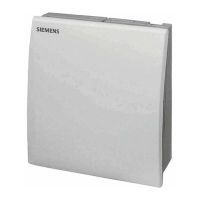
Do you have a question about the Siemens QFA2000 and is the answer not in the manual?
| Brand | Siemens |
|---|---|
| Model | QFA2000 |
| Category | Accessories |
| Language | English |
Details compatible systems and recommended signal converters for averaging passive sensors.
Sensor acquires relative humidity via capacitive element, converting to DC 0-10 V signal.
Sensor acquires temperature via resistance element, outputting DC 0-10 V or passive signals.
Electronic circuit compensates for self-heating impact on passive sensor resistance measurements.
Provides graphs showing characteristics for simulated LG-Ni 1000 and T1 (PTC) sensing elements.
Describes using the shorting plug in vertical position to activate test function outputs.
Guidelines for cable routing, selection, interference, and using shielded/twisted pair cables.
Specifies optimal location for sensor installation to ensure accurate readings.
Notes on sealing conduits and finding instructions on the product packaging.
